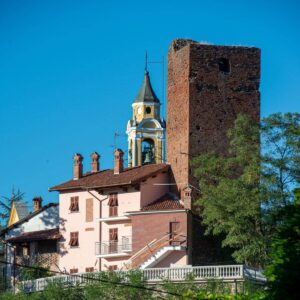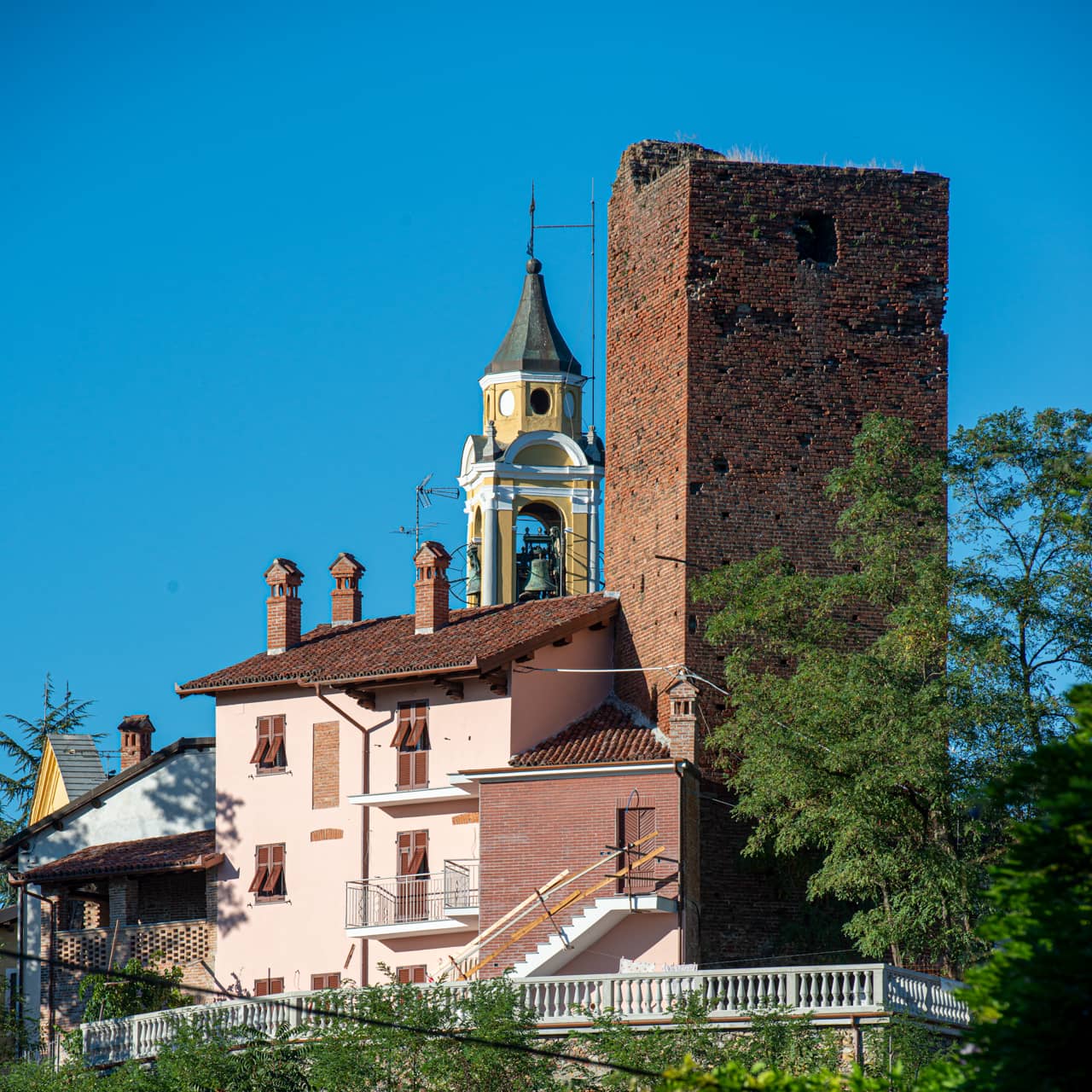The place where the municipality is located was also inhabited in prehistoric times: this is evidenced by the findings, in the Albedosa-Tramontanino area on the Sangiu dei strie areniaria boulder, of cupmarks and pediform signs from the Middle Iron Age.
“Further confirmation of the presence of Ligures‘ demic centers in the area, due to its fortunate location, comes from recent archaeological excavations in the San Nicolao area, which have uncovered artifacts of funerary activity from the 5th-5th centuries BC. C.. In Roman times, the territory of Capriata belonged to the agro dertonense […]. Numerous traces have remained of the Roman presence, starting with the large stele of St. Agatha (1st century AD) found in the Orba in 1926, which assigns the territory to the Roman tribe Pomptina (the same to which the inhabitants of Dertona belong) to end with the recent discovery of the remains of a rural building in the Panattiano locality (1st century AD) […].” (from M. Tambussa, Guide to Capriata d’Orba, 2006, pp. 4-5.)
Findings and studies would confirm the presence of a minor roadway, used to join the two major consular roads in the area: the Via Postumia and the Aemila Scauri.
“With the advent of the Lombards, the urbem vastissimam silvam (the Orba forest mentioned by the chronicler Paul Deacon) a hunting place reserved for their kings […] came to the fore.” (from M. Tambussa, Guide to Capriata d’Orba, 2006, p. 7.)






THE WAR OF CAPRIATA
In 1224, a bloody battle, remembered as the Capriata War, was fought in the Capriata territory, which had as its background the clash between Emperor Frederick II and the Lombard League allied with the Pope that pitted Alexandria and Genoa against each other.
The battle led the Alexandrians adhering to the League to conquer Capriata, but the men of Capriata present under the command of a certain Bonsignore D’Arena drove the Alexandrians back with a catapult.
There were then reprisals by the Alexandrians who settled in the Borgo and rebuilt the burned houses and fortified it.
What to see in Capriata d’Orba
- LA TORRE DEL CASTEL VECCHIO E LE RELIQUIE DEL PASSATO
- CHIESA DI S. PIETRO APOSTOLO
- ORATORIO DI SAN MICHELE
- ORATORIO DI SAN GIUSEPPE
- MONASTERO DEI FRATI CONTEMPLATIVI
- MULINO
- SOCIETÀ AGRICOLA DI MUTUO SOCCORSO
GOLF CLUB VILLA CAROLINA
The imposing ruins of the Castel Vecchio tower are the remains of a fortification that, in the Middle Ages, preceded the construction of the town. This must have been part of a chain of towers that, starting from Parodi, the Torre del Gazzo in San Cristoforo, Torre dell’Albarola in Lerma and the one on Mount Colma, protected, in Carolingian times, the Orba and Lemme valleys from Saracen raids.
A few sections of wall and the tower remain of the castle; the old town wall is also nearby.
“But Capriata can also boast of other vestiges of its past: on the ring road and the small square some sections of old city walls; on San Antonio Street and San Giovanni Street 15th-century houses; on Tigliano Street two 1400s terracotta windows; some frescoes, mullioned windows,
various epigraphs scattered along the old streets of the village.” (from M. Tambussa, Guide to Capriata d’Orba, 2006, p. 25.)
Numerous place names recall structures that have disappeared or been repurposed. The Convent area, the 1855 San Gioacchino Hospital, the Gabella where Genoa kept salt for Lombardy, the Pedaggera farmstead where tolls were paid. The Cascina Ospedale, a mispronunciation of hospitale for pilgrims in the Oltre Orba area, which existed in 1196; the Villa Fortezza Aureliana, which stands in the middle of the large Gazzolo forest (it is speculated that it stood over an ancient Templar building and is said to have hidden Giuseppe Mazzini); the Cascina San Bernardino, where the saint is said to have slept in 1417-1418, later giving it its name.
The building is of Romanesque origin and has undergone countless reconstructions during the Modern Age. A fragment of stone decoration now walled under the portico remains of the original structure.
“The first historical document dates back to 1204, but the building, which had existed for centuries, was subject to the parish of Santa Maria in Lemure. […] In the left aisle, we find the beautiful altar, with four twisted columns of polished black African marble, dedicated to the Blessed Virgin of the Assumption (a chaplaincy established by Belengerio Bertolotto in 1401), and later becoming, by order of Pius V of Bosco Marengo, Our Lady of the Rosary or Queen of Victories following the Battle of Lepanto (1571).” (from M. Tambussa, Guide to Capriata d’Orba, 2006, pp. 27-29.)
The sacristy is furnished with Baroque-style cabinets made of walnut, a stupendous work of Piedmontese craftsmanship, which hold chalices and pyx by Genoese goldsmith and engraver Torretta.
The 1791 octagonal bell tower measures 41.50 meters in height and has five bells.
Among the works preserved here are:
- a beautiful processional crucifix weighing 105 kg;
- the statue of St. Bovo (painted wood, 16th century) from the vanished Franciscan monastery in Capriata;
- the Baroque altar of Our Lady of the Rosary;
- a Sacred Conversation from the Luca Cambiaso area and the other canvases of the seventeenth-century Genoese school.
It houses the Casaccia of St. Michael, the oldest in the village, which already existed in 1494 and joined the Casaccia of H.H. Trinity in 1682.
The interior is covered by a barrel vault, frescoed by Pietro Ivaldi, known as “the mute of Ponzone,” with his brother Tommaso and Giuseppe Ferraris, who worked mainly as quadraturists.
Among the treasures it holds are:
- A small bell from 1544;
- Several seventeenth-century paintings;
- The statues of St. Michael and St. Defendant;
- A valuable organ by the Agati firm of Pistoia, dated 1839;
- A processional cross made of pink wood covered with embossed silver.
The brethren wear the traditional red cape.
The oratory is dedicated to the Most Holy Annunciation. The building is located a few steps from the tower of the Castel Vecchio. Its construction apparently dates back to 1674, while the bell tower was erected in 1727. In 1888, the Oratory suffered a fire that caused serious damage, especially to the furnishings. Throughout the 20th century, several renovations were carried out, however, during World War II, two bells were taken from the Ministry of War Production so that they could be used to make weapons.
Inside it holds:
- a marble high altar by sculptor Brugnetti (1765);
- a walnut choir by masters Zaverio and Pulacini;
- an organ from the Bianchi company in Novi;
- a silver cross made by goldsmith Gio.Canepa in 1844.
During religious rites, the brethren wear white capes with blue tabards.
It was established in 1970 in the Bricco villa of Cavalier Brizzolesi, thanks to the donation of Marchesa Carolina Finocchio in Giavotti.
In the lower part of the village stands the Mill (the first document mentioning it dates back to 1186 and is a bull of Urban III). With its hydraulic power it provided the first electric light to the village in 1911.
It was founded in 1975 and found its home in the present building in 1908. A historic building that houses members very active in the area in helping the poor.
In the middle of a centuries-old park with its elegant clubhouse, housed in what was once Marquis Gavotti’s summer residence.
It covers an area of more than 110 hectares and includes two courses of 18 and 9 holes with a total length of 9730 meters.
It is frequented by numerous VIPs from Italy and abroad.














